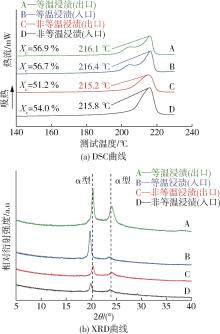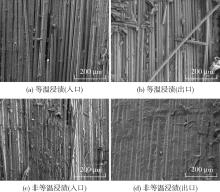京ICP备13020181号-2
© 《China Plastics》
© 《China Plastics》

China Plastics ›› 2022, Vol. 36 ›› Issue (9): 1-6.DOI: 10.19491/j.issn.1001-9278.2022.09.001
• Materials and Properties • Next Articles
JIA Mingyin( ), DONG Xianwen, WANG Jiaming, CHEN Ke
), DONG Xianwen, WANG Jiaming, CHEN Ke
Received:2022-04-02
Online:2022-09-26
Published:2022-09-26
CLC Number:
JIA Mingyin, DONG Xianwen, WANG Jiaming, CHEN Ke. Effect of impregnation method on vacuum bag press molding process and properties of polyamide 6 composites[J]. China Plastics, 2022, 36(9): 1-6.
Add to citation manager EndNote|Ris|BibTeX
URL: https://www.plaschina.com.cn/EN/10.19491/j.issn.1001-9278.2022.09.001
| 浸渍方式 | GF含量/% | 密度/ | 孔隙率/% | |||
|---|---|---|---|---|---|---|
| 入口 | 出口 | 入口 | 出口 | 入口 | 出口 | |
| 非等温浸渍 | 70.37 | 73.08 | 1 787.69 | 1 849.32 | 1.427 | 0.796 |
| 等温浸渍 | 69.86 | 72.54 | 1 776.83 | 1 841.03 | 0.709 | 0.672 |
| 浸渍方式 | GF含量/% | 密度/ | 孔隙率/% | |||
|---|---|---|---|---|---|---|
| 入口 | 出口 | 入口 | 出口 | 入口 | 出口 | |
| 非等温浸渍 | 70.37 | 73.08 | 1 787.69 | 1 849.32 | 1.427 | 0.796 |
| 等温浸渍 | 69.86 | 72.54 | 1 776.83 | 1 841.03 | 0.709 | 0.672 |




| 1 | GONG Y, YANG G. All⁃polyamide composites prepared by resin transfer molding[J]. Journal of Materials Science, 2010, 45(19): 5 237⁃5 243. |
| 2 | ZALDUA, MAIZ, CALLE D L, et al. Nucleation and crystallization of PA6 composites prepared by T⁃RTM: effects of carbon and glass fiber loading[J]. Polymers, 2019, 11(10): 1 680⁃1 699. |
| 3 | Abderrahim Maazouz, Khalid Lamnawar, Mohamed Dkier. Chemorheological study and in⁃situ monitoring of PA6 anionic⁃ring polymerization for RTM processing control[J]. Composites Part A, 2018, 107(8): 235⁃247. |
| 4 | Luisier A, Bourban P E, Månson J A E. Reaction injection pultrusion of PA12 composites: Process and modelling[J]. Composites Part A: Applied Science & Manufactu⁃ring, 2003, 34(7): 583⁃595. |
| 5 | Epple S, Bonten C. Production of continuousfiber thermoplastic composites by in⁃situ pultrusion [C]//AIP Conference Proceedings. American Institute of Physics, 2014, 1593(1): 454⁃457. |
| 6 | CHEN K, JIA M Y, SUN H, et al. Thermoplastic reaction injection pultrusion for continuous glass fiber⁃reinforced polyamide⁃6 composites[J]. Materials, 2019, 12(3): 463⁃477. |
| 7 | Rijswijk K V, Teuwen J J E, Bersee H E N, et al. Textile fiber⁃reinforced anionic polyamide⁃6 composites. Part I: The vacuum infusion process[J]. Composites Part A: Applied Science & Manufacturing, 2009, 40(1): 1⁃10. |
| 8 | Rijswijk K V, Lindstedt S, Vlasveld D P N, et al. Reactive processing of anionic polyamide⁃6 for application in fiber composites: A comparitive study with melt processed polyamides and nanocomposites[J]. Polymer Testing, 2006, 25(7): 873⁃887. |
| 9 | Van Rijswijk K, Bersee HEN, Beukers A, et al. Optimisation of anionic polyamide⁃6 for vacuum infusion of thermoplastic composites: Influence of polymerisation temperature on matrix properties[J]. Polym Test, 2006, 25(3): 392⁃404. |
| 10 | Teuwen J J E, Ang H S A, Bersee H E N. Post⁃processing of anionic polyamide⁃6 composites[J]. Macromolecular Materials & Engineering. 2010, 20(4): 896⁃903. |
| 11 | TeuwenJulie JE, GeenenAA van, BerseeHarald EN. Vacuum⁃infused anionic polyamide⁃6 composites: The effect of postprocessing[J]. Journal of Thermoplastic Composite Materials, 2012, 25(8):965⁃986. |
| 12 | Barbosa L C M, Duque G R V, Junior A C A. Temperature⁃frequency⁃dependent properties analysis of a bio⁃composite based on a new liquid thermoplastic resin reinforced with jute fibers[J]. Journal of Thermoplastic Composite Materials, 2020(3): 1⁃21. |
| 13 | HAO S, XIA L J, GUO Z L, et al. Manufacture and performance of textile⁃ramie fiber reinforced anionic polya⁃mide 6 composites[J]. Fibers and Polymers, 2019, 20(8): 1 705⁃1 715. |
| 14 | Teuwen J, Gillis J, Bersee H. Optimisation of infusion temperature for anionic polyamide⁃6 composites[C]//Aiaa/asme/asce/ahs/asc Structures, Structural Dynamics, & Materials Conference Aiaa/asme/ahs Adaptive Structures Conference 10t. 2013. |
| 15 | Teuwen J T E, van Rijswijk K, Bersee H E N, et al. Effect of fibre textile reinforcement on anionic polyamide⁃6 composite properties[C]//Proceedings of the 16th International Conference on Composite Materials, Kyoto, Japan. 2007: 8⁃13. |
| 16 | Jean⁃François Charron. Vacuum infused anionic polyami⁃de⁃6 composites a quest for uniformity[D]. Canada:Ecole de Technologie Superieure, 2011. |
| 17 | Teuwen J J E. Thermoplastic composite wind turbine blades: kinetics and processability[D]. Aerospace Engineering, 2011. |
| 18 | ASTM.Standard Test Methods for Flexural Properties of Unreinforced and Reinforced Plastics and Electrical Insulating Materials:ASTM D⁃790 [S] USA:ASTM, 2007. |
| 19 | ASTM.Standard Test Method for Short⁃Beam Strength of Polymer Matrix Composite Materials and Their Laminates:ASTM D⁃2344 [S] USA: ASTM, 2016. |
| 20 | Cartledge H C Y, Baillie C A. Studies of microstructural and mechanical properties of nylon/glass composite Part I: The effect of thermal processing on crystallinity, transcrystallinity and crystal phases[J]. Journal of Materials Science, 1999, 34(20): 5 099⁃5 111. |
| 21 | Ricco L, Russo S, Orefice G, et al. Anionic poly (ε⁃caprolactam): Relationships among conditions of synthesis, chain regularity, reticular order, and polymorphism[J]. Macromolecules, 1999, 32(23): 7 726⁃7 731. |
| [1] | ZHANG Lin, XIA Zhangchuan, HE Yadong, XIN Chunling, WANG Ruixue, REN Feng. Influence of gas flow of plasma jet carrier on modification effect for glass fiber [J]. China Plastics, 2022, 36(9): 7-15. |
| [2] | GAO Yonghong, PENG Mengmi, JIN Qingping. Temperature effect on bond performance between glass fiber reinforcement polymer bars and concrete [J]. China Plastics, 2022, 36(9): 16-23. |
| [3] | DONG Yue, DONG Xiao, ZHU Dezhao, YANG Yanxiang, LUO Chen, LI Yang, LI Jinshan. An overview of development and application prospects of polyimide products [J]. China Plastics, 2022, 36(9): 85-95. |
| [4] | LI Zhuolin, MU Wenying, DING Yumei. Research status and development trend of medical radiation protective clothing [J]. China Plastics, 2022, 36(9): 193-201. |
| [5] | JIAO Zhiwei, WANG Kechen, ZHANG Yang, YANG Weimin. Performance of PVC/ABS composites filled with carbon black and talc powders based on carbon nano coating deposition [J]. China Plastics, 2022, 36(8): 10-15. |
| [6] | HU Chenguang, SU Hang, FENG Xiaoxin, DING Feng, LI Enshuo, FU Jiawei. Preparation and properties of waste glass⁃fiber⁃reinforced plastic⁃modified asphalt [J]. China Plastics, 2022, 36(8): 119-126. |
| [7] | YU Darong, XIN Yong. Research progress in modification of ultrahigh molecular weight polyethylene [J]. China Plastics, 2022, 36(8): 135-145. |
| [8] | YU Jiuyang, WANG Zhonghao, CHEN Qi, XIA Yazhong. Study on properties of advanced resin matrix composites for valve body manufacturing [J]. China Plastics, 2022, 36(8): 16-22. |
| [9] | ZHANG Taozhong, CHEN Xiaolong, HAO Xiaoyu, YU Fujia. Comparison of mechanical properties and interfacial interactions of polypropylene composites filled with talc, calcium carbonate, and barium sulfate [J]. China Plastics, 2022, 36(8): 36-41. |
| [10] | CHEN Baiquan, ZHENG Youming, TIAN Jibo, XHANG Lei, WANG Jinsong, LIN Xiajie, DUAN Yapeng. Preparation and properties of polyamide flame⁃retardant composite reinforced with high content of glass fiber [J]. China Plastics, 2022, 36(8): 42-48. |
| [11] | DU Qing, HE Yi, YU Tanjing, LAN Yanjiao, ZHAO Yanzhi, ZHOU Juying. Preparation and characterization of oriented thermoplastic polyolefin/PAN/ MWCNT composites [J]. China Plastics, 2022, 36(8): 49-55. |
| [12] | QU Yuting, WANG Limei, QI Bin. Effect of poly(ethylene glycol) on properties of poly(lactic acid)/starch nanocrystal composites [J]. China Plastics, 2022, 36(8): 56-61. |
| [13] | WEI Simiao, SHAO Lushan, XU Zhun, LIU Yanting, ZHAO Siheng, XU Bo. Flame⁃retardant performance of PA6 modified with hypophosphite/siloxane bi⁃functional compound and diethyl aluminum hypophosphite compound [J]. China Plastics, 2022, 36(7): 129-135. |
| [14] | FENG Bingtao, WANG Xiaoke, ZHANG Xin, SUN Guohua, WANG Dianlong, HOU Lianlong, MA Jinsong. Preparation and application of continuous carbon⁃fiber⁃reinforced thermoplastic composites [J]. China Plastics, 2022, 36(7): 165-173. |
| [15] | SONG Yinbao, YANG Jianjun, LI Chuanmin. Study on properties and manufacturing precision of PDMS/SiC functionally gradient composites [J]. China Plastics, 2022, 36(7): 30-36. |
| Viewed | ||||||
|
Full text |
|
|||||
|
Abstract |
|
|||||